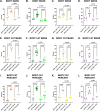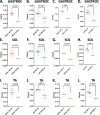ATF4-dependent and independent mitokine secretion from OPA1 deficient skeletal muscle in mice is sexually dimorphic
- PMID: 39381436
- PMCID: PMC11458430
- DOI: 10.3389/fendo.2024.1325286
ATF4-dependent and independent mitokine secretion from OPA1 deficient skeletal muscle in mice is sexually dimorphic
Abstract
Introduction: Reducing Optic Atrophy 1 (OPA1) expression in skeletal muscle in male mice induces Activation Transcription Factor 4 (ATF4) and the integrated stress response (ISR). Additionally, skeletal muscle secretion of Fibroblast Growth Factor 21 (FGF21) is increased, which mediates metabolic adaptations including resistance to diet-induced obesity (DIO) and glucose intolerance in these mice. Although FGF21 induction in this model can be reversed with pharmacological attenuation of ER stress, it remains to be determined if ATF4 is responsible for FGF21 induction and its metabolic benefits in this model.
Methods: We generated mice with homozygous floxed Opa1 and Atf4 alleles and a tamoxifen-inducible Cre transgene controlled by the human skeletal actin promoter to enable simultaneous depletion of OPA1 and ATF4 in skeletal muscle (mAO DKO). Mice were fed high fat (HFD) or control diet and evaluated for ISR activation, body mass, fat mass, glucose tolerance, insulin tolerance and circulating concentrations of FGF21 and growth differentiation factor 15 (GDF15).
Results: In mAO DKO mice, ATF4 induction is absent. Other indices of ISR activation, including XBP1s, ATF6, and CHOP were induced in mAO DKO males, but not in mOPA1 or mAO DKO females. Resistance to diet-induced obesity was not reversed in mAO DKO mice of both sexes. Circulating FGF21 and GDF15 illustrated sexually dimorphic patterns. Loss of OPA1 in skeletal muscle increases circulating FGF21 in mOPA1 males, but not in mOPA1 females. Additional loss of ATF4 decreased circulating FGF21 in mAO DKO male mice, but increased circulating FGF21 in female mAO DKO mice. Conversely, circulating GDF15 was increased in mAO DKO males and mOPA1 females, but not in mAO DKO females.
Conclusion: Sex differences exist in the transcriptional outputs of the ISR following OPA deletion in skeletal muscle. Deletion of ATF4 in male and female OPA1 KO mice does not reverse the resistance to DIO. Induction of circulating FGF21 is ATF4 dependent in males, whereas induction of circulating GDF15 is ATF4 dependent in females. Elevated GDF15 in males and FGF21 in females could reflect activation by other transcriptional outputs of the ISR, that maintain mitokine-dependent metabolic protection in an ATF4-independent manner.
Keywords: FGF21; insulin resistance; integrated stress response; mitochondria; obesity.
Copyright © 2024 Streeter, Persaud, Gao, Manika, Fairman, García-Peña, Marti, Manika, Gaddi, Schickling, Pereira and Abel.
Conflict of interest statement
The authors declare that the research was conducted in the absence of any commercial or financial relationships that could be construed as a potential conflict of interest.
Figures







References
MeSH terms
Substances
Grants and funding
LinkOut - more resources
Full Text Sources
Molecular Biology Databases
Research Materials

